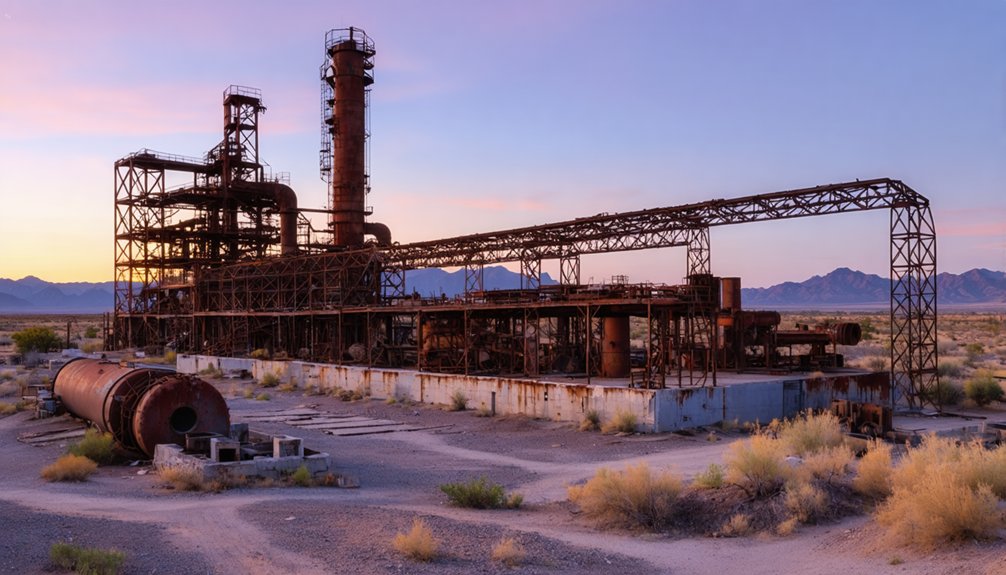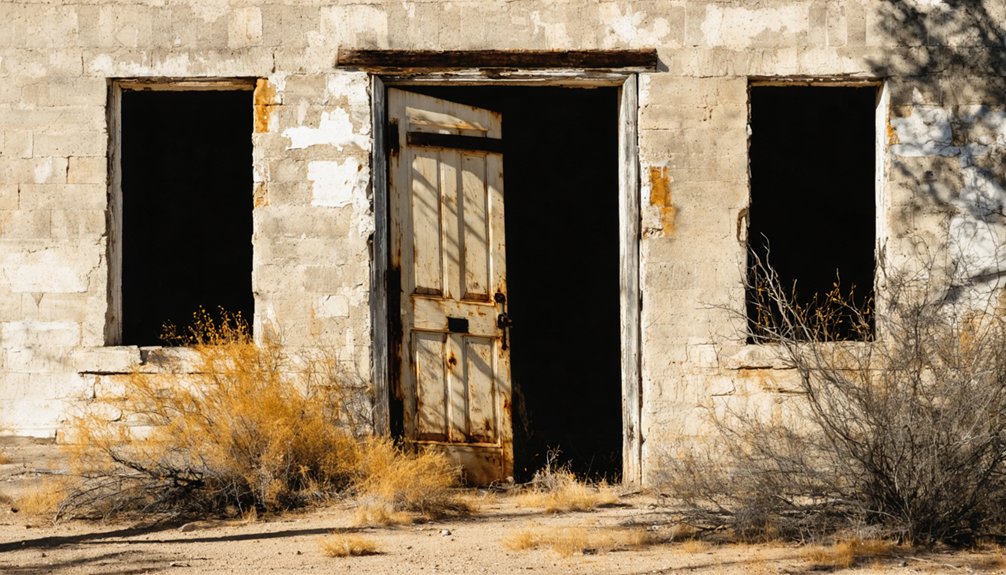You’ll find Rustler Springs in Texas’s Trans-Pecos region, where abandoned sulfur mines stand as remnants of a once-thriving mining settlement. Established in 1854 after William P. Blake discovered sulfur deposits, the town flourished in the early 1900s with the introduction of the Frasch extraction process. The community, which briefly hosted a post office named Tarver (1908-1910), supported both mining and ranching before economic forces led to its abandonment. The site’s complex history mirrors America’s broader quest for domestic sulfur production.
Key Takeaways
- Rustler Springs was established in 1854 after sulfur discoveries and became a mining town focused on sulfur extraction.
- The town briefly had a post office named Tarver from 1908-1910, indicating its peak period of settlement.
- Located in Texas’s Trans-Pecos region, the town developed around sulfur mining operations using the Frasch extraction process.
- A diverse community of White and Mexican residents lived there, supported by ranching and mining activities.
- The town declined due to economic challenges and environmental factors, with residents leaving for better opportunities elsewhere.
The Lost Sulfur Mining Settlement
Sulfur deposits near Rustler Springs first caught scientific attention in 1854 when geologist William P. Blake reported finding acidic sulfur earth in Culberson County, Texas. Initially viewed as potential fertilizer, these deposits later sparked industrial development with the establishment of a sulfur plant in the early 1900s.
The industry’s development reflected the growing importance of sulfur as basic raw material in chemical manufacturing. The Frasch extraction process, which involved melting sulfur with superheated water, revolutionized sulfur mining across Texas. You’ll find that unlike the Gulf Coast’s Frasch-process operations, sulfur extraction here focused on surface and near-surface deposits in gypsum. The settlement briefly supported a post office named Tarver from 1908-1910, marking its peak as a mining community.
While mining technology evolved elsewhere, particularly with Duval Corporation’s 1967 Frasch pilot operation near Fort Stockton, Rustler Springs’ sulfur operations remained relatively small-scale. The settlement gradually faded as larger, more profitable Gulf Coast operations dominated the market.
Geographic Features and Natural Resources
The Trans-Pecos region of Texas provides the dramatic backdrop for Rustler Springs, where complex geological formations tell a deeper story than the ghost town’s mining past.
You’ll find yourself surrounded by the distinctive Rustler Hills, an irregular belt of low elevations that breaks through an otherwise flat, eastward-sloping plain.
The area’s unique geology stems from the Rustler Formation, containing rich deposits of dolomite, limestone, and sandstone.
The layers of Rustler Formation reveal nature’s artistry through its rich symphony of dolomite, limestone, and sandstone deposits.
You’ll notice the landscape’s dissected plains, marked by arroyos that channel toward the Pecos River. Beneath the surface, the Rustler Aquifer holds precious groundwater resources within its permeable layers.
The region’s mineral resources include notable sulfur deposits, while marine fossils in the dolomite layers reveal an ancient seabed history that shaped today’s terrain.
Mining Operations and Economic Impact
During the late 19th and early 20th centuries, Rustler Springs emerged as a promising sulfur mining district, though its production never reached the scale of other Texas mineral operations.
You’ll find evidence of early commercial sulfur extraction attempts that yielded small amounts of refined product, with companies like Freeport Sulphur and Duval Corporation exploring the area’s potential.
The district faced significant economic challenges, particularly due to shallow workings that couldn’t adequately reach deeper deposits. Texas’s vast mineral resources contributed over $3.39 billion to the state economy by 2012, highlighting the broader importance of mining operations statewide.
While the sulfur plant operations created jobs and spurred local development, including railroad infrastructure and community services, the industry’s eventual decline led to Rustler Springs’ transformation into a ghost town.
Today, you can still see remnants of these mining operations, silent testimonies to the area’s industrial past that represent an important chapter in Texas state history, preserved through community support and documentation.
Life in Early Rustler Springs
Situated in Culberson County’s rugged Apache Mountains, Rustler Springs emerged as a frontier settlement where pioneer families like Ed Hamm, George Bristow, and Jack Veats established roots alongside the Texas and Pacific Railroad line.
You’d find a diverse early community of White and Mexican residents, with men outnumbering women due to the area’s strong ranching heritage. Life wasn’t easy in this semi-arid climate, but the presence of sulfur springs provided essential water sources for settlers. The Duck Creek Rustler newspaper had also established itself as a vital source of community news in the region. With only ten inches of annual rainfall, residents had to carefully manage their water resources.
The railroad’s influence spurred growth in nearby towns like Van Horn, which became a significant cattle-shipping center. As you explored the settlement, you’d notice how the ranching culture and geographical isolation shaped the lives of these hardy pioneers, who were primarily of Hispanic, English, and Irish descent.
The Decline and Abandonment
Like many frontier settlements of its era, Rustler Springs faced a gradual decline driven by shifting economic forces and environmental challenges.
Similar to nearby towns like Paducah that lost two-thirds of residents, the population steadily dwindled over several decades. You’ll find that improved transportation networks and technological advancements reduced the need for small, isolated settlements like this one. As residents moved away seeking better opportunities in larger towns, the community disintegration accelerated, leading to closed businesses and reduced tax revenue.
Similar to Eagle Springs, the absence of railroad access ultimately sealed the town’s fate. The town’s cultural heritage slowly faded as essential services disappeared and agricultural activities dwindled. Nature began reclaiming abandoned structures while harsh weather conditions hastened their deterioration.
What’s particularly striking is how this pattern mirrors countless other frontier towns that couldn’t adapt to changing times. The exodus of residents meant not just empty buildings, but the loss of a once-vibrant community’s way of life.
Remnants and Current Site Conditions
The industrial remnants of Rustler Springs center around the abandoned Duval sulphur plant, which operated through 1969 when the Atchison, Topeka and Santa Fe Railroad built a connecting spur. Similar to the pioneers of McDow in the 1860s who settled remote areas, these early industrial workers faced isolation and harsh conditions. J.F. Carter served as the local postmaster from 1908 to 1910.
In west Texas, the ghost town of Rustler Springs stands as testament to sulfur mining’s legacy and the railroad era.
Today, you’ll find an isolated landscape that preserves a significant piece of Texas’ industrial heritage, located 42 miles north of Kent.
While archaeological challenges include overgrown vegetation and natural erosion, you can still access the site via 2WD roads to explore:
- Plant foundations and equipment remnants from early 20th-century sulfur operations
- Scattered industrial artifacts including machinery fragments and railroad components
- Historic construction materials and hardware dating to the 1900s
- The surrounding Rustler Hills terrain, which provides context for the ghost town’s remote setting
Legacy in Texas Mining History

While today’s remnants tell only part of Rustler Springs’ story, its lasting influence on Texas mining history began in 1854 when William P. Blake discovered sulfur during a U.S. War Department expedition.
You’ll find the site’s historical significance deeply rooted in America’s quest for domestic sulfur supplies, which became essential in the early 20th century.
The region’s legacy extends beyond its initial discovery. From the 1940s fertilizer production to Duval Corporation’s successful Frasch operations near Fort Stockton in 1967, Rustler Springs helped pioneer sulfur extraction techniques in West Texas.
The area’s economic impact transformed Culberson County, spawning facilities like the Rock House Facility and creating important employment opportunities.
Though the town no longer bustles with mining activity, its role in shaping Texas’s mineral extraction industry remains undisputed.
Frequently Asked Questions
Are There Any Dangerous Abandoned Mine Shafts to Avoid in Rustler Springs?
Like scattered footprints of the past, abandoned mines here don’t pose major safety concerns. You’ll find shallow, partially filled shafts rather than dangerous deep pits to worry about.
What Is the Closest Modern Town or City to Rustler Springs?
You’ll find Kent’s your closest modern town, about 42 miles south, though it’s small with limited modern amenities. For more local attractions and services, head to Pecos or Toyah.
Can Visitors Legally Explore or Metal Detect in Rustler Springs?
Want to explore freely? You can’t – it’s now a residential area. Metal detecting regulations and visitor access guidelines require property owner permission for any exploration or detecting activities.
Were There Any Notable Accidents or Deaths During Mining Operations?
While mining tragedies were common throughout Texas, there’s no documented evidence of major accidents or deaths at Rustler Springs’ sulfur operations, though modern safety regulations weren’t yet established in its early days.
Did Native American Tribes Have Any Connection to the Sulfur Deposits?
You’ll find limited evidence of Native connections to Rustler Springs sulfur deposits, though regional tribes like Manso, Suma, and Jumano likely knew the area’s sulfur significance through hunting and seasonal movements.
References
- https://southwritlarge.com/articles/the-curse-of-old-town-spring/
- https://www.youtube.com/watch?v=SaUCT73CKnY
- https://theforgottensouth.com/cheapside-texas-ghost-town-history/
- https://www.southernthing.com/ruins-in-texas-2640914879.html
- https://www.treasurenet.com/threads/subletts-lost-mine-culberson-county-texas.1348/page-4
- https://en.wikipedia.org/wiki/List_of_ghost_towns_in_Texas
- https://www.tshaonline.org/handbook/entries/rustler-tx
- https://www.tshaonline.org/handbook/entries/rustler-springs-tx
- https://www.ghosttowns.com/states/tx/rustlersprings-tarver-sulphuria.html
- https://www.texasescapes.com/TOWNS/Texas-Ghost-Towns-2-Central-Texas.htm



